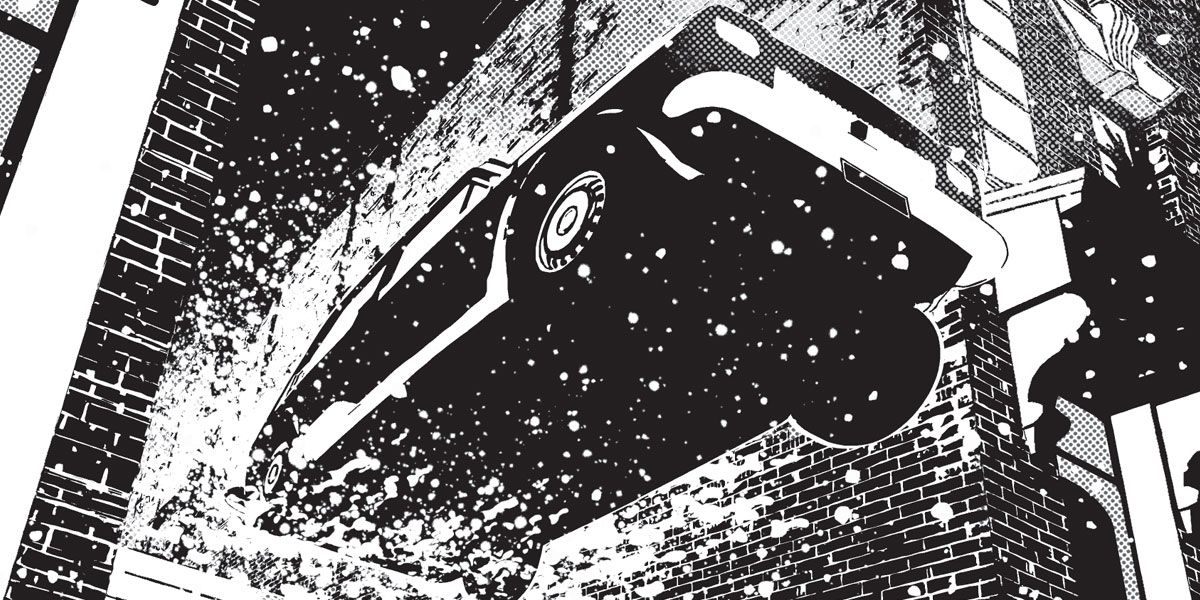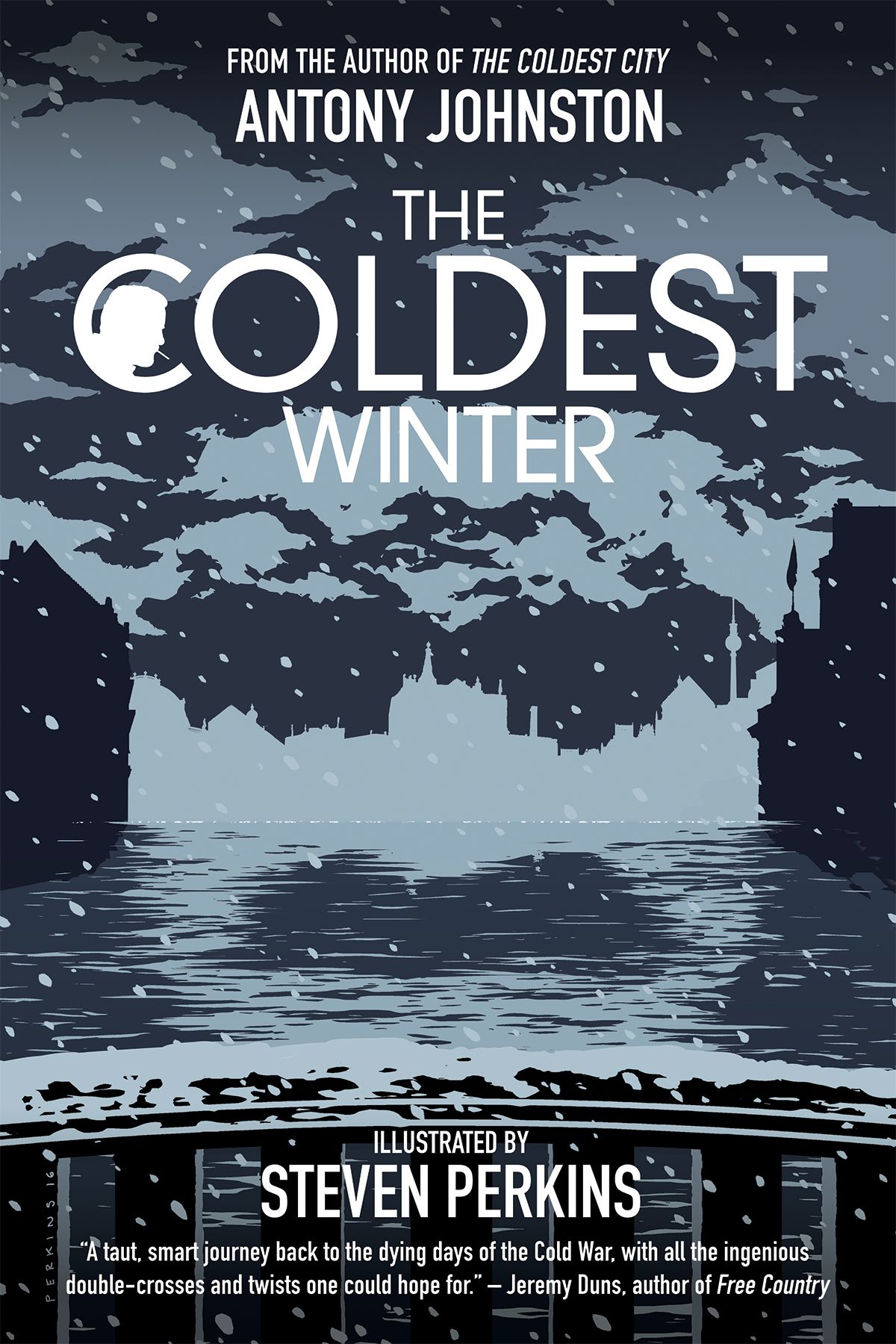Antony Johnston has written more than thirty comics-slash-graphic novels, including “Wasteland,” “The Fuse” and “Codename Baboushka.” He’s also written video games like “Dead Space” and “Shadow of Mordor," and hosts the podcast Unjustly Maligned. Steven Perkins is the artist of many comics including “Se7en,” “Heresy” and various “CSI” projects. He also wrote and drew the graphic novel “Pacify,” which was published by Image Comics. Their latest project, out now from Oni Press, is “The Coldest Winter.”
Johnston and artist Sam Hart’s 2012 graphic novel “The Coldest City” was a realistic spy thriller set in Berlin. This year, the film adaptation – titled “Atomic Blonde” – will be released, starring Charlize Theron, James McAvoy, John Goodman and directed by David Leitch (“John Wick”). Before that, Oni Press is releasing a prequel to the book. “The Coldest Winter,” written by Johnston and illustrated by Steven Perkins, set in 1981 Berlin, during one of the most brutal winters on record and featuring one of the key characters from the first book.
Antony, could you talk about “The Coldest City” for people who are coming to it for the first time
Antony Johnston: Sure. “The Coldest City” is a Cold War spy thriller set in 1989, just two weeks before the Berlin Wall came down. A British spy is killed crossing from East to West Berlin, while carrying a list of spies in the city. Now the list is missing, and MI6 don’t know who they can trust — so they send in Lorraine Broughton, a veteran officer with no ties to Berlin, to find out the truth in the social powder keg of the divided city. Things get – messy.
I’m a big fan of classic Cold War spy fiction, especially the more realistic writers like John Le Carré, Len Deighton, and Ian Mackintosh. “The Coldest City” was my attempt to revitalize that area using the medium I know best — graphic novels.
So what is “The Coldest Winter?”
Johnston: “The Coldest Winter” is the second book in the “Coldest series,” but takes place eight years before the first and focuses on David Perceval — who in “The Coldest City” is the shadowy MI6 chief in Berlin, but here is a newly-arrived spy in the city. And he’s not making a very good job of it; in fact, he’s about to be sent back to England after one too many botched jobs.
But before he goes, there’s the small matter of a high-ranking Soviet scientist who wants to defect — during a winter so severe that travel in or out of the city is impossible. So now Perceval has to keep the scientist safe from the KGB, improvising a game of cat and mouse through a frozen city, all the while plotting revenge. With this book, I really wanted to give some context to Perceval’s character, and his personality in “The Coldest City.” Frankly, in that book he’s a fairly unpleasant man. “The Coldest Winter” helps explain why.
Steven at what stage of things did you come onto the project?
Steven Perkins: When Oni asked me if I would like to work on the book, the script was finished and the project was ready to go. I loved “The Coldest City” and the script for “The Coldest Winter” was fantastic, so I was really excited about the opportunity to work with Antony and with the fine folks at Oni. It's a big book — 184 pages — and a period-specific story, so it seemed like a real challenge artistically which made it even more exciting to work on.
How much of the time and energy on a book like this is spent on research and getting the details right?
[vn_gallery name="The Coldest Winter preview" id="1029971"]
Johnston: Quite a bit, because it’s both a mystery and historical fiction, and both of those things rely on verisimilitude and an attention to detail to keep the reader immersed, to not accidentally jolt them out of the story. What I try to do is use those historical details, and the interlocked nature of a mystery plot, to my advantage; probably the biggest example in “The Coldest Winter” is the entire setting for the book, the heavy blizzard-filled winter that descended on Europe at the end of 1981. That really happened, and it really did shut down roads, trains, and airlines. So I made it the foundation of the whole story. If you can make those details overt, deliberate parts of the story, and rely on people paying attention, it makes for a better book and a better experience for the reader.
Perkins: Getting the details right was very important to me, too. I was still in diapers in 1981, so I had to rely on a lot of research and reference to avoid any anachronisms – particularly with the cars, military uniforms, and technology. Also, “1980's Cold War History” would definitely not be my strong suit on Jeopardy, but luckily right before I was invited to work on the project, I had been helping an artist friend with backgrounds for his book which also took place in 1980's Berlin – so coincidentally, I had just finished doing tons of research on the exact time and place needed for “The Coldest Winter” right before I started.
Johnston: Ha! I didn’t know that. What a crazy stroke of good luck.
When working on a prequel like this, are you thinking that it has to look or feel like the original, that it should be separate and have its own identity. Steven you didn’t draw the first book so I’m sure you have a different sort of answer than Antony, but how did both of you approach the book?
Johnston: Well, “look” and “feel” are two separate things. Steven’s art is very different to Sam Hart’s, but they both have that lovely stark, noir-ish quality to them; and of course the story itself, the pacing and dialogue, definitely has the same kind of feel as “The Coldest City,” because that to me is the style of the series. But the stories are quite different, and each book retains its own identity; you don’t need to have read either of them to enjoy the other, and the same will be true of the third book.
Perkins: I think Sam Hart’s work on “The Coldest City” is outstanding, so I felt like I had a lot to live up to with “The Coldest Winter.” I’ve always wanted to do a full book in straight black and white — in the past, all of my black and white work had gray tones, which makes it much easier to render objects and people. Working with only black and white is a challenge, but it also serves to make an artist need to be more creative — it’s like having only two tools instead of a full tool set to accomplish the same result. You end up learning more and, in my opinion, doing better and more rewarding work. Plus, it opens the door to doing very minimal, graphic work which can achieve results, particularly with snow, that are much more striking than when rendered with tones or color. Also, some of my favorite comic book artists — Mike Mignola, Frank Miller, Alberto Breccia — are well known for their mastery of black and white minimalism, so I studied their work obsessively and learned a lot in the process.
Was it hard to get 1981-82 right?
Johnston: Not that hard for me, but I have the unfair advantage of growing up in 1970s Europe!
Perkins: I hope I did get it right! The internet is a Godsend for artistic and historical reference, and so it was very helpful to be able to watch footage from 1980's Germany on YouTube, or find thousands of photos of the Berlin Wall with a Google search.
Antony, rereading “The Coldest City,” there was a line that jumped out at me when characters are discussing the end of the Cold War - “Russia will always be Russia.”
Johnston: And how prophetic that turned out to be!
I have to ask about the movie version of “The Coldest City,” which is coming out soon. Do you want to say anything about “Atomic Blonde,” Antony?
Johnston: “Atomic Blonde” is based on the first graphic novel in the series, starring Charlize Theron, James McAvoy, John Goodman, Sophia Boutella, Toby Jones and more. The screenplay was adapted by Kurt Johnstad, and for director we landed David Leitch, who co-directed “John Wick” and recently signed on to “Deadpool 2.” I mean, the talent list is kind of ridiculous, just packed with great people.
It opens July 28, and there’ll be a lot more news coming over the next few months. I can’t wait.
I recently finished a new novel, hopefully the first in a series, and I’ll have more to say about that soon; I’m halfway through scripting the next series of “Codename Baboushka” for Image; I’m planning a new fantasy project with an old friend; an indie videogame I worked on, “Blackwood Crossing,” is set to debut imminently; and there are more screen projects, both movies and TV, that are sort of bubbling under. I like to keep busy.
Perkins: I have a handful of creator-owned comic book projects of my own and with other writers that I am trying to get off the ground, so whichever one lifts off first will be my next project. In the meantime, I've been busy with motion comics and comic book work, but am not allowed to mention any specifics just yet. I've also been filling in gaps with some storyboard and visual effects work for film as well.
Antony, do you still have plans for a third book – or more – in the Coldest series?
Johnston: Absolutely, and I’ve already begun preliminary work. It’ll bring the focus back to Lorraine Broughton again, but beyond that my lips are sealed. Walls have ears, you know.


